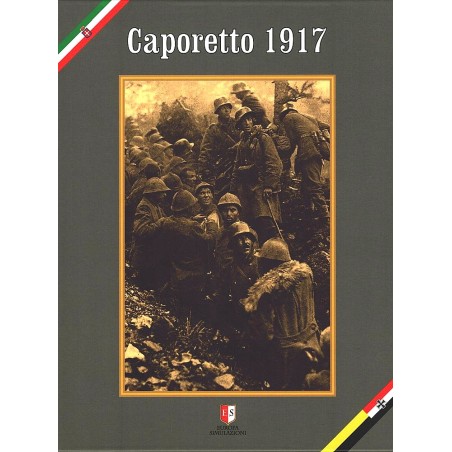









The Great War Vol.III
Caporetto 1917
After Strafexpedition 1916, and Gorizia 1916, the third chapter is added to the Great War series: Caporetto 1917.
Caporetto 1917 proposes the rules of the system in their updated version, to recreate, at battalion and company level, the most famous, tragic and controversial event of the Great War on the Italian Front.
 Security guarantees
Security guarantees
100% secure payments: PayPal, Visa, MasterCard, bank cards, alternative payments.
 Delivery policy
Delivery policy
Deliveries by Mondial Relay or Colissimo (French fast postal service).
 Returns policy
Returns policy
Returns accepted up to 14 days after delivery
Historical introduction
Caporetto is a picturesque mountain village, located in the upper Soča valley. It has always been a border town; his German name is Karfreit, and its Slovenian name is Kobarid, but for the story he has the Italian name. Probably the most famous battle in Italian history, it is synonymous with "catastrophe", and in use in the Italian language with the same meaning. Also known as the Twelfth Battle of the Isonzo, the Battle of Caporetto was the aftermath of the Eleventh Battle of the Isonzo, which saw the Italian army advance across the Isonzo River, creating a dangerous salient for both Ljubljana and Trieste. To drive the Italians back, and make them unable to carry out new offensives quickly, an offensive was needed, but the weakened Austro-Hungarian Empire lacked sufficient resources. German help was therefore needed. Aid materialized in the 14th Army, composed of some of the best German divisions, experienced in mountain warfare, and returning from successes in Riga and Romania. But above all that they employed unknown tactics and materials on the Italian front. Operation "Waffentreue " (Fedeltà d'Armi) was born, with the aim of pushing back the Italians to the Tagliamento. The results went beyond expectations. Recall the story of the first fateful days of that battle.
The Battle
The third volume of the series proposes, in turns of 12 hours each, the first four decisive days of the battle of Caporetto, in four scenarios:
1. The historical battle: The complete battle in the first four days, with the historical disposition of the Italian Army, in which the two players are both attacking and defending, respectively manoeuvering one wing of each side: attacking with an Austro-German wing, defending with the Italian one opposite the opponent. Each player, or team of players, will have to reach their goals faster than the opponent.
2. The battle that might have been: The battle as it might have been if the Italians had been better prepared. The clash is between the Italian player, who can arrange his troops more carefully and respond more quickly to the enemy manoeuvres, and the Austro-German player, however stronger, who must break through against a prepared enemy.
3. The Battle of Cividale: The final phase of the breakthrough on the Italian right flank. A short scenario, to learn the system, or commit a little time.
4. The Fall of Monte Maggiore: The final phase of the breakthrough on the Italian left flank. This is also a short and undemanding scenario.
Highlights
The game system has been updated and refined in version 2.0. It is based on the concept of action and reaction by the formations, typically brigades or regiments, which make up the opposing armies. It is a system that requires planning in the activation of formations, provides for a lot of interaction between them, and, at first glance, it may seem demanding. The use of artillery is greatly important, as it is the morale of the fighting troops, which can deteriorate as a result of fatigue or fighting.
Components:
A 22"x34" map covering the battlefield area, from Monte Canin and Rombon in the West, to the bridgehead of Tolmino in the East, from Bovec and Monte Nero in the North to Cividale and the Friuli plain in the South a reduced map of the Tolmin beachhead, for managing artillery in that congested sector
1400 counters
System rules and specific rules for the game, including Rommel Grouping ( Rommel Abteilung ), Stosstruppen, gas and mine attacks, the Fog of Caporetto, and more
Very detailed order of battle, the result of years of research and information gathering
Terrain Effects Chart, Assault and Bombardment Tables sheet; sheets to contain: German battalions, which can be divided into companies
Assignment sheet for Italian formations
Sheet for eliminated units, Turn Record Track and Logistics Points.
Designer: Andrea Brusati